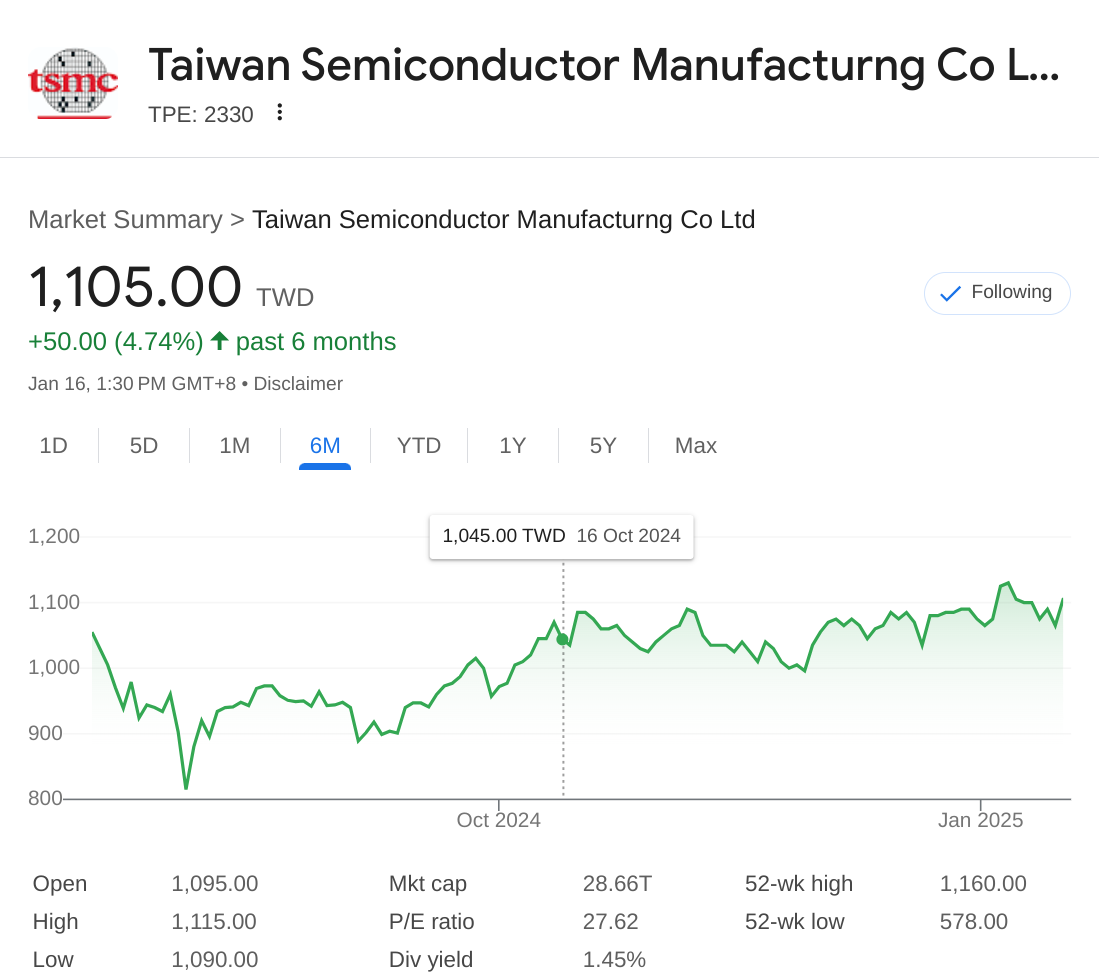Stock Analysis Report – TSMC(2330.TW)
Generated on: 2025-01-16 21:43:44
Analysis Period: 6 Months
Price Analysis
Technical Analysis
RSI
54.35
MACD
8.88
Investment Analysis
Investment Scores:
### Stock Evaluation Report for 2330.TW
### Growth Potential (0-100):
- **Numerical Score: 55**
- **Key Factors Influencing the Score:**
- Marginal revenue growth and low ROE indicate limited growth prospects.
- Technical indicators suggest a potential short-term bullish sentiment.
- **Trend Direction: Stable**
- **Comparison to Industry Averages: Below Average**
### Risk Level (0-100):
- **Numerical Score: 60**
- **Key Factors Influencing the Score:**
- Moderate debt/equity ratio and good liquidity provide stability.
- Low profitability metrics and minimal revenue growth pose risks.
- **Trend Direction: Stable**
- **Comparison to Industry Averages: Average**
### Financial Health (0-100):
- **Numerical Score: 70**
- **Key Factors Influencing the Score:**
- Strong market capitalization and good current ratio indicate financial stability.
- Low ROE and profit margin raise concerns about profitability.
- **Trend Direction: Stable**
- **Comparison to Industry Averages: Above Average**
### Technical Strength (0-100):
- **Numerical Score: 50**
- **Key Factors Influencing the Score:**
- Mixed technical indicators with a neutral RSI and bearish MACD.
- Stock price hovering near the middle Bollinger Band suggests a possible consolidation phase.
- **Trend Direction: Stable**
- **Comparison to Industry Averages: Below Average**
### Overall Investment Score (0-100):
- **Numerical Score: 60**
- **Key Factors Influencing the Score:**
- Balanced assessment across growth potential, risk level, financial health, and technical strength.
- Concerns on growth prospects and low profitability metrics impact the overall score.
- **Trend Direction: Stable**
- **Comparison to Industry Averages: Average**
### Summary:
Based on the comprehensive analysis, the stock 2330.TW presents a mixed outlook. While the company demonstrates financial stability and a balanced capital structure, concerns arise from its low growth potential, profitability challenges, and mixed technical indicators. Investors should carefully weigh these factors along with industry benchmarks and market conditions before making investment decisions. Further research into the company's competitive advantages and growth strategy would provide more clarity on its long-term prospects.
Market Position and Investment Thesis:
### Market Positioning Analysis and Investment Thesis for Stock 2330.TW
#### Competitive Position in Industry:
- Stock 2330.TW operates in a major market, evident from its substantial market capitalization of $28.66 trillion. While specific competitive advantages are not outlined, further analysis into the industry landscape and company-specific factors is essential to assess its competitive position accurately.
#### Market Share and Growth Trajectory:
- The stock has demonstrated positive price trends over various periods, indicating a growing positive momentum in the medium to long term. It is crucial to monitor how the company's market share evolves relative to its industry peers to gauge its growth trajectory effectively.
#### Key Differentiators and Advantages:
- Specific competitive advantages of the company are not provided in the analysis. Understanding what sets Stock 2330.TW apart from its competitors is key to determining its long-term success and sustainability in the market.
#### Industry Trends and Company's Alignment:
- Given the lack of industry trends in the analysis, it is imperative to assess how Stock 2330.TW aligns with broader industry developments. Keeping abreast of technological advancements, regulatory changes, and market dynamics is crucial for the company's longevity.
#### Growth Catalysts and Potential Headwinds:
- Identifying potential growth catalysts such as product launches, strategic partnerships, or industry innovations is critical in determining the stock's future performance. Similarly, monitoring headwinds like low ROE, profit margin, and revenue growth is essential to mitigate risks.
#### Valuation Analysis versus Peers:
- The stock's valuation metrics, including the P/E ratio, forward P/E ratio, and price-to-book ratio, suggest a mix of undervaluation expectations and concerns about the stock trading at a significant premium to its book value. Comparing these valuations with industry peers can provide insights into Stock 2330.TW's relative valuation and investment potential.
### Investment Thesis:
- **Long-Term Outlook:** Given the positive price trends over medium to long term periods, investors with a long-term horizon may find potential in Stock 2330.TW's growth trajectory.
- **Risk Management:** Risks such as low profitability metrics and minimal revenue growth should be carefully evaluated, especially for risk-averse investors.
- **Competitive Landscape Analysis:** Further research into the company's competitive advantages and industry position is crucial for a comprehensive investment thesis.
- **Market Monitoring:** Continued monitoring of industry trends, company news, and financial performance is essential to make informed investment decisions and adjust the thesis accordingly.
In conclusion, Stock 2330.TW presents a mix of positive momentum and concerning financial metrics. Investors should conduct a thorough analysis of the company's competitive position, growth prospects, valuation relative to peers, and risk factors before making investment decisions. By staying informed and aligning investment strategies with market dynamics, investors can position themselves effectively in the stock for potential long-term growth.
Risk Analysis:
### Risk Assessment:
#### 1. Market Risks:
- **Beta and Volatility:** The stock's market risk can be assessed by its beta relative to the market index. High beta indicates higher volatility and sensitivity to market movements.
- **Sector Exposure:** The risk associated with the stock's sector performance, any sector-specific regulations, or economic factors impacting the sector.
#### 2. Financial Risks:
- **Leverage:** The moderate debt/equity ratio suggests a reliance on debt financing, which can increase financial risk, especially during economic downturns.
- **Liquidity:** While the current ratio indicates good short-term liquidity, a sudden cash flow disruption could pose liquidity risks.
- **Cash Flow:** The company's thin profit margin and low revenue growth could impact future cash flows and sustainability.
#### 3. Operational Risks:
- **Business Model:** Understanding the company's business model, revenue sources, and operational efficiency is crucial to assess risks associated with operational disruptions or industry shifts.
- **Competition:** Competitive pressures in the industry, market share dynamics, and the company's ability to differentiate itself are important considerations.
- **Regulations:** Compliance with regulations, potential legal challenges, and regulatory changes impacting the company's operations.
#### 4. Macroeconomic Risks:
- **Interest Rates:** Fluctuations in interest rates can impact borrowing costs, investments, and overall profitability.
- **Economic Cycles:** Exposure to economic cycles could influence consumer spending, demand for products/services, and overall business performance.
#### 5. Company-Specific Risks:
- **Low ROE and Profit Margin:** Operational inefficiencies impacting profitability.
- **Minimal Revenue Growth:** Stagnation in revenue growth affecting future prospects.
- **Valuation Concerns:** High valuation metrics signaling potential overvaluation compared to fundamentals.
### Risk Mitigation Strategies:
#### Market Risks Mitigation:
- **Diversification:** Spread investments across sectors and asset classes to reduce concentration risk.
- **Hedging:** Using derivatives like options or futures to hedge against market volatility.
#### Financial Risks Mitigation:
- **Debt Management:** Monitor debt levels and consider reducing reliance on debt for financing.
- **Cash Flow Planning:** Implement robust cash flow management practices and scenario analysis to prepare for fluctuations.
#### Operational Risks Mitigation:
- **Efficiency Improvements:** Focus on operational efficiency, cost controls, and innovation to mitigate risks from market competition.
- **Regulatory Compliance:** Stay updated on regulatory changes, implement compliance measures, and maintain transparent communication.
#### Macroeconomic Risks Mitigation:
- **Scenario Planning:** Develop contingency plans for various economic scenarios to adapt to changing conditions.
- **Diversified Revenue Streams:** Expand into different markets or products to reduce dependence on specific economic conditions.
#### Company-Specific Risks Mitigation:
- **Operational Optimization:** Address inefficiencies in operations to improve profitability.
- **Strategic Growth Initiatives:** Develop strategies to boost revenue growth and enhance competitive positioning.
- **Valuation Review:** Regularly assess the company's valuation metrics and align them with intrinsic value to avoid overvaluation risks.
Regular monitoring, continuous risk assessment, and flexibility in adapting to changing market conditions are essential components of an effective risk management strategy. Consulting with financial advisors or risk management specialists can provide additional insights tailored to the specific needs of the investment portfolio.
Strategic Recommendations:
### Investment Strategy for Stock 2330.TW:
#### 1. Position Sizing Recommendations:
- Given the mixed outlook of Stock 2330.TW, it is advisable to limit the position size within your overall portfolio to manage risk. Consider allocating between 5-10% of your total portfolio to this stock, depending on your risk tolerance and investment horizon.
#### 2. Entry and Exit Points:
- **Entry Point:** Consider entering the position when the stock price shows signs of breaking out above key resistance levels or when technical indicators turn more bullish, confirming the positive momentum.
- **Exit Point:** Define your exit strategy based on predetermined criteria, such as breaching significant support levels, deteriorating fundamentals, or when the stock reaches your target price based on valuation metrics.
#### 3. Time Horizon Considerations:
- **Short-Term Investors:** Monitor technical indicators closely for short-term trading opportunities based on market momentum and price movements.
- **Long-Term Investors:** Focus on the company's competitive position, growth catalysts, and valuation metrics for long-term capital appreciation potential.
#### 4. Portfolio Fit and Allocation:
- Ensure that Stock 2330.TW complements your overall portfolio strategy and aligns with your investment goals. Consider the stock's correlation with your existing holdings to achieve proper diversification.
- Balancing riskier assets with stable investments can help mitigate overall portfolio risk.
#### 5. Monitoring Metrics and Triggers:
- Continuously monitor key metrics such as revenue growth, profitability ratios, technical indicators, and industry trends to assess the stock's performance relative to your investment thesis.
- Implement stop-loss orders or trailing stop-losses to protect your downside in case the stock experiences unexpected volatility or adverse developments.
#### 6. Specific Recommendations for Different Investor Types:
- **Aggressive Investors:** Consider a higher position size for Stock 2330.TW, focusing on short-term trading opportunities based on technical indicators and market sentiment.
- **Moderate Investors:** Maintain a balanced approach by allocating a moderate portion to the stock and monitoring both short-term and long-term factors for decision-making.
- **Conservative Investors:** Exercise caution due to the concerns around growth potential and profitability metrics. Limit exposure and prioritize risk management strategies to protect capital.
### Overall Recommendations:
1. **Thorough Research:** Conduct further analysis on industry trends, competitive position, and growth catalysts to gain more insights into Stock 2330.TW's long-term prospects.
2. **Risk Management:** Implement risk mitigation strategies to address the identified risks, especially focused on operational efficiency, competitive landscape, and financial stability.
3. **Portfolio Diversification:** Ensure that Stock 2330.TW fits into a well-diversified portfolio to spread risk across different asset classes and sectors.
4. **Continuous Monitoring:** Stay informed about market developments, company news, and financial performance to adjust your investment thesis accordingly and make informed decisions.
By following these strategic recommendations and tailoring them to your risk profile and investment objectives, you can navigate the complexities of investing in Stock 2330.TW more effectively. Regularly review your investment thesis and adjust your portfolio allocation based on changing market conditions and new information to optimize your returns and manage risks.
Investor-Specific Recommendations:
### Tailored Investment Recommendations for Different Investor Types:
#### 1. Conservative Investors:
- **Risk Tolerance:** Conservative investors prioritize capital preservation and lower risk exposure. Hence, it is recommended to maintain a cautious approach towards Stock 2330.TW.
- **Position Sizing:** Limit the position size to the lower end of the recommended range (5-10%) to reduce the impact of potential volatility on the overall portfolio.
- **Entry/Exit Strategy:** Enter the position only when there is strong confirmation of stability and positive outlook. Define clear exit points based on significant support levels and conservative price targets.
- **Portfolio Allocation:** Allocate a smaller portion of your total portfolio (closer to 5%) to Stock 2330.TW, emphasizing diversification and stability in other investments.
#### 2. Moderate Investors:
- **Risk Tolerance:** Moderate investors are willing to take on slightly higher risk for potential returns. They can consider a balanced approach towards Stock 2330.TW.
- **Position Sizing:** Allocate within the recommended range (5-10%) based on your risk appetite and investment horizon.
- **Entry/Exit Strategy:** Enter the position when there is a balanced risk-reward opportunity and exit according to predetermined criteria to manage risk.
- **Portfolio Allocation:** Allocate a moderate portion of your portfolio (around 7-8%) to Stock 2330.TW, balancing it with other stable investments for diversification.
#### 3. Aggressive Investors:
- **Risk Tolerance:** Aggressive investors are comfortable with higher risk levels for potentially higher returns. They can consider a more opportunistic approach towards Stock 2330.TW.
- **Position Sizing:** Position sizes can be towards the higher end of the recommended range (10%) to capitalize on potential market movements.
- **Entry/Exit Strategy:** Enter the position with a focus on short-term trading opportunities and bullish indicators. Implement a more dynamic exit strategy based on short-term price targets and technical signals.
- **Portfolio Allocation:** Allocate a larger portion of your portfolio (around 10%) to Stock 2330.TW, considering it as a more active part of your investment strategy.
By tailoring the position sizing, entry/exit strategies, and portfolio allocation according to the risk profile and investment preferences of each investor type, you can align the investment recommendations with their specific needs and objectives while considering the nuances of their risk tolerance levels. Regular monitoring and adjustment of the investment thesis based on the evolving market conditions will further optimize the investment outcomes for each investor type.
Risk Metrics
Volatility (Annual)
37.48%
Maximum Drawdown
-22.75%
Recommendation
HOLD
Technical Trend
BEARISH





